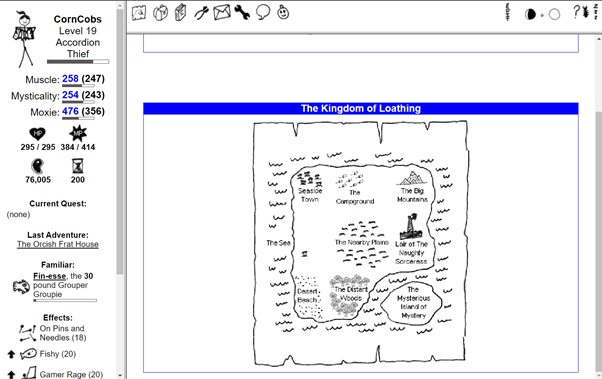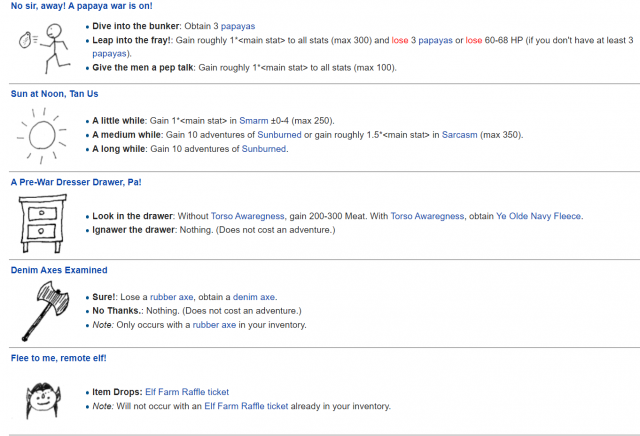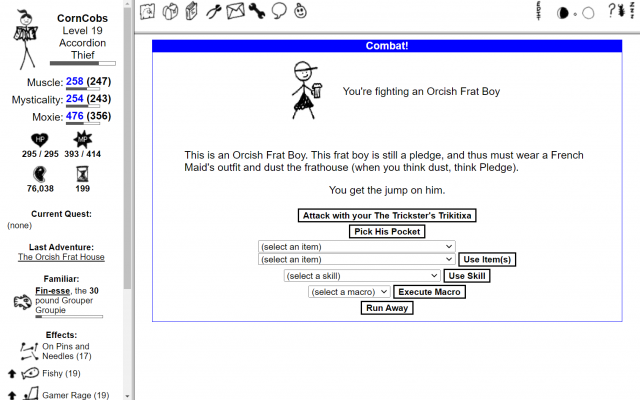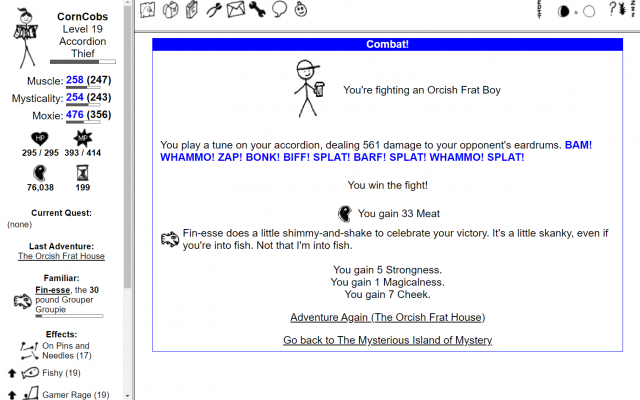Description
The Kingdom of Loathing is a turn-based, comedy/satirical Role Playing Game (RPG), played on the browser. The game’s slogan is “An Adventurer is you!” and this reflects the free-spirited nature of the game – you are an adventurer, and what you want to do on your adventures is up to you!
Website: The Kingdom of Loathing
First quick look: Kingdom of Loathing Gameplay – First Look HD – YouTube

Every real-world day, the player is given 40 adventures, and the player spends their adventures by clicking on the many locations within the many areas on the island. Adventuring at places could result in battles, or certain events happening which could let the player find items, gain status effects or complete quests. Additionally, the player can also craft items, smith weapons and equipment, and cook food and mix booze, and consuming drinks and eating gives the player additional adventures for that day.

While the player is free to do whatever they want with their adventures, there is a more or less linear storyline the player can follow, which involves completing quests given out by the Council of Loathing, starting from simple quests like searching for mosquito larva at the spooky forest to creating and ending a war between hippies and frat boys, culminating in the final quest – to defeat the Naughty Sorceress.
After defeating the Naughty Sorceress, the player can then continue to adventure, growing even stronger, or can choose to ascend to Valhalla, where one receives karma for various good deeds they did in their life. The player then can choose to be reborn from level 1, in a new class, and take up various ascension challenges in their next life, such as being unable to access their inventory from previous lives. The player can use the karma they earn to bring skills they learnt into their next lives. Ascension and reincarnation thus effectively offers the player infinite replayability, and the developers occasionally release new ascension path challenges that keep the game fresh.
The Elemental Tetrad
Technology: The game was released in 2003 and its interface has not changed significantly since then. Images are mostly static and each click refreshes the page. The use of the universal platform of the internet allowed the game to be played on any device with a browser, even feature phones. However, there is no doubt that appealing to the lowest denominator may cause the game to lose appeal with those who desire more interactivity and better graphics.
Mechanics: The game mechanics are extremely simple and uniform. Every adventure involves clicking through choices, even battles (choosing whether to attack, use skills or items, or run away). Crafting involves attempting to combine any set of items in your inventory together. However, this lends the game a lot of flexibility as the possibilities from these open interactions are endless. A large part of the fun is figuring out what interactions are possible using logic, figuring out textual clues, or accumulated knowledge over multiple ascensions.
Story: The storytelling in the game is a major element that makes it interesting. While I mentioned that there is a linear storyline, how you go about finishing your quests is left for you to discover. The council sends the player on extremely random quests with hilarious motivations, which gradually unlocks more and more of the map. However, they leave it to the player to go and adventure, figure out what needs to be done and choose how they want to solve it. For example, in the Frat boy/Hippie war, do you side with the Hippies and defeat the Frat boys? Or the other way around? Or do you calculate exactly how many enemies to defeat on both sides so that they wipe each other out? There are also side stories in addition to the main quests. Ultimately it is up to the player to write their own adventure.
Aesthetic: The game has an extremely unique aesthetic which appeals to some and not others. The images are all either static or simple gifs, and are mostly hand-drawn stick-figures, which some may find funny, while others lazy. Some may enjoy the many subtle puns and references, while others may find it too noisy.
The Lens of Fun (#5)
This is the key lens underlying the experiences of this game – it is meant to be fun, and not taken seriously. There are few serious consequences in the game – even if you lose all your HP, you merely receive a “Beaten up” status and spend some adventures resting at your campsite. Casual players can simply wait to the next day to receive more adventures and continue their journey, and slowly enjoy the many jokes and references peppered throughout the kingdom. Examples:
- The currency of the game is Meat, not gold, since the creator felt that it was nonsensical for monsters to drop money when defeated
- The classes. Your character can pick from 6 classes which follow the wizard/warrior/thief archetypes. Except the classes include Pastamancers, who wield pasta magic and whose Nemesis is the Flying Spaghetti Monster, and Seal Clubbers, warriors from the frigid north, which is poking fun at typical Northern “Savage” warrior classes such as Vikings in other RPGs.
- The Penultimate Fantasy Airship, an adventurable area, is a parody of Final Fantasy, where one fights trope-y enemies like the Protagonist, Spunky Princess and Quiet Healers
- The Palindome is another area where all adventures involve palindromes. Even the boss (Dr. Awkward) is a palindrome.

The Lens of the Puzzle (#58)
There are many unexpected possibilities in the game, in crafting, or in quest completion.
- Crafting anticheese + goat cheese = goat, and anticheese + cottage cheese = cottage
- There is a monster called the Fancy Bath Slug, which can only be defeated with an item called fancy bath salts
The game gives sufficient hints so one need not always refer to the wiki for clues.
The Lens of Challenge (#38)
The regular gameplay is very simple for casual playthrough, but there are always greater challenges for more serious players. For example, one may challenge oneself to complete a full ascension within 1 day – this requires serious planning, strategy and efficient use of resources. There are also special seasonal ascension challenges, such as “Bees hate you”, where one cannot use, eat, or wear anything that contains the letter ‘B’.
The Lens of Community (#98)
While the playthrough may seem to be mainly single-player, players can chat with other logged in players via chat in the side panel, buy and sell items via the Marketplace, or form guilds and clear guild dungeons together. Furthermore the developers are highly involved and often introduce world-wide events, such as Crimbo (KOL’s Christmas), where on one occasion, players had to work together to save Crimbo from mutant elves and the penguin mafia. Overall, the non-serious aspect of the game fostered a fun and helpful community where people could give advice to newer players and share knowledge. This is very important for a game full of Easter Eggs like Kingdom of Loathing.


